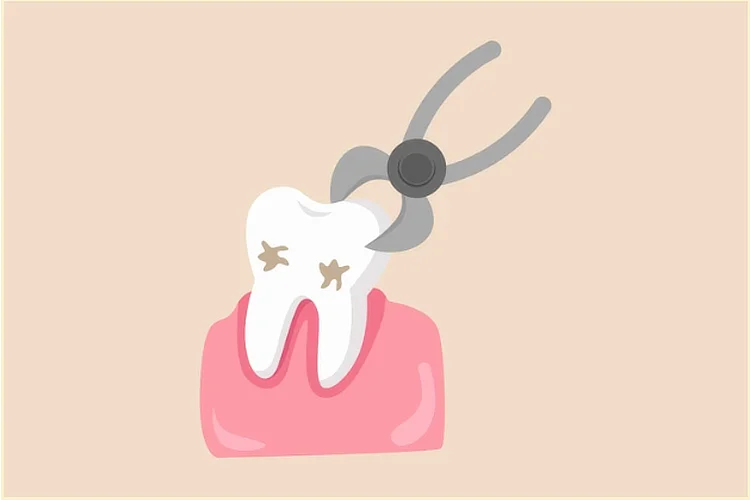Tooth Extraction
Information reviewed by: Dr. Tay Chih Kien, B.D.S (Singapore) | Last updated: Nov 03, 2025
| Treatment | Tooth Extraction |
| Purpose | To remove a tooth that is beyond repair due to severe decay, damage, infection, impaction, or overcrowding |
| Price |
Milk Tooth Extraction: $49.05 to $98.10, inclusive of GST Adult Tooth Extraction: $98.10 to $272.50, inclusive of GST |
| Treatment Duration | Simple extraction usually takes 20 to 40 minutes. Surgical extraction may take longer depending on complexity. |
| How to Book | Book via WhatsApp: 9667 1828 or Email: hello@truedental.sg |
| Clinic Location | 728 Ang Mo Kio Avenue 6, #01-4228, Singapore 560728 |
When Is a Tooth Extraction Needed?
A tooth extraction may be needed when a tooth cannot be saved through restorative treatment. Common reasons include:
- Severe tooth decay or infection that has damaged most of the tooth structure
- Advanced gum disease causing loose or unstable teeth
- Impacted or partially erupted wisdom teeth that trap food and bacteria
- Fractured teeth below the gum line or in complex patterns
- Unsuccessful previous dental treatment, such as root canal therapy
- Creating space for orthodontic treatment, such as braces or clear aligners, when teeth are overcrowded
In many cases, replacing an extracted tooth with options such as dental implants, bridges, or dentures helps restore function and maintain long-term oral health.

What Are Types of Tooth Extractions?
There are two main types of tooth extractions depending on the tooth’s condition and position.
| Type of Extraction | Description |
|---|---|
| Simple Extraction |
The tooth is loosened with an instrument and removed with forceps. Local anaesthesia is
applied to numb the area beforehand.
This type of extraction is commonly performed for teeth that are decayed, damaged, or loose but fully erupted. |
| Surgical Extraction |
A small incision is made in the gum to reach a tooth that is broken, impacted, or not
visible. Bone may be removed or the tooth divided into sections, and stitches are
sometimes placed to aid healing. Local anaesthesia is typically used, with sedation
sometimes offered.
This type of extraction is often required for complex cases such as impacted wisdom teeth or teeth fractured below the gum line. |

WhatsApp Us Now
Tooth Extraction Recovery Timeline
Recovery from a tooth extraction usually takes about one week for a simple extraction and up to three weeks or longer for a surgical extraction. The bone and gums will continue to heal gradually over several months. Most people can return to normal daily activities within one to two days.
Tips for Tooth Extraction Recovery
After a tooth extraction, good aftercare helps protect the blood clot, reduce swelling, and support healing. Common tips include:
- Bite gently on the gauze provided for 30 to 60 minutes. Discard the gauze and check if bleeding has stopped. If bleeding persists, repeat as necessary with another clean gauze.
- Apply a cold compress to the cheek at short intervals during the first 24 to 48 hours
- Take prescribed or over-the-counter pain relief, such as paracetamol, as directed
- Avoid smoking, alcohol, vigorous rinsing, spitting, or using straws for at least 24 hours
- Brush your other teeth normally but avoid the extraction site, and begin gentle saltwater rinses after 24 hours to keep the area clean
- Eat soft foods such as porridge, yoghurt, or mashed potatoes in the first few days

Always follow your dentist’s instructions carefully, as recovery needs may differ depending on whether the extraction was simple or surgical.
What Are the Risks and Possible Complications?
Tooth extraction is a routine procedure, but complications may occur in some cases. These include:
- Dry socket, where the blood clot dislodges and exposes the bone
- Prolonged bleeding or delayed healing
- Infection at the extraction site
- Nerve irritation or sinus involvement in rare cases of upper tooth extractions
You should contact your dentist if you experience worsening pain after a few days, persistent bleeding, increasing swelling, or signs of infection such as fever or pus.
What Is the Cost of Tooth Extraction in Singapore?
At True Dental Studio, our prices for tooth extractions are as follows:
| Treatment | Price* |
|---|---|
| Consultation | $27.25 to $65.40 |
| Second Opinion Consultation | $27.25 to $65.40 |
| Milk Tooth Extraction | $49.05 to $98.10 |
| Adult Tooth Extraction | $98.10 to $272.50 |
| Wisdom Tooth Extraction | $163.50 to $272.50 |
| Wisdom Tooth Extraction (Oral Surgeon) | $272.50 to $436 |
| Wisdom Tooth Surgery | $981 to $1,362.50 (MediSave-claimable) |
| Wisdom Tooth Surgery (Oral Surgeon) | $1,635 to $2,180 (MediSave-claimable) |
*Prices are NETT and inclusive of GST.
What Are Alternatives to Tooth Extraction?
Alternatives to tooth extraction aim to preserve the natural tooth when it is still restorable. These treatments are usually considered before removal, and the most suitable option depends on the extent of damage, infection, and overall oral health.
- Dental fillings or crowns – Repair teeth with decay, cracks, or fractures that still have enough healthy structure to be preserved.
- Root canal treatment – Removes infection from inside the tooth and seals it, often followed by a crown to strengthen the tooth.
- Periodontal treatment – Treats gum disease through deep cleaning and other methods to stabilise loose teeth.
How Do I Book a Tooth Extraction Appointment?
Book Tooth Extraction Appointment
Book NowEnquire More Through Email
Email Us NowEnquire More Through WhatsApp
WhatsApp Us NowWhy Choose True Dental Studio?
Friendly Dentist and Team
Our team treats each and every patient to the best of our ability. This is the reason why entire families have continued their dental care with True Dental Studio for many years, from all over Singapore.
Minimal Discomfort
At True Dental, it is our commitment to ensure our patients are kept as comfortable as possible. We aim to minimize discomfort, if any, for our patients.
Affordable Treatments
We believe in pricing quality treatments at a competitive rate. We are transparent and upfront with our treatment costs.
Our Smile Scorecard
Frequently Asked Questions
The main do’s after tooth extraction are to bite on gauze for 30 to 60 minutes, apply cold compresses, take pain relief as directed, and eat soft foods. The main don’ts are smoking, drinking alcohol, using straws, spitting forcefully, or rinsing vigorously in the first 24 hours. Always follow your dentist’s instructions carefully to protect the blood clot, support proper healing, and reduce the risk of complications.
Day 3 after tooth extraction is often the most uncomfortable because swelling peaks and the blood clot is still fragile. Pain and tenderness may temporarily feel more intense before gradually improving. Most people find symptoms begin to ease from day 4 onwards. It is advisable to consult a dentist if pain worsens or swelling increases after this period, as it could indicate infection or complications.
It is not recommended to eat or chew normally on the side of a recent tooth extraction, as the socket needs time to heal. Soft foods are advised for the first few days, with solid foods reintroduced gradually as comfort allows. Very hot, crunchy, or spicy foods should be avoided early in recovery, and chewing should be done on the opposite side of the mouth until healing progresses. Always follow your dentist’s instructions for optimal recovery.
Wisdom teeth, especially impacted lower ones, are commonly regarded as the most painful to extract due to their position and the complexity of surgery. Impacted teeth are those that do not fully emerge through the gum, often becoming trapped against bone or other teeth. Simple extractions of front teeth are usually quicker and involve less discomfort. However, pain varies depending on the tooth’s condition, the procedure, and individual healing responses.
On the first night after tooth extraction, it is usually recommended to sleep with your head slightly elevated using extra pillows to help reduce swelling and bleeding. Avoid lying flat or putting pressure on the extraction side. It is advisable to consult a dentist for guidance on the most suitable sleeping position for your situation to protect the healing blood clot during rest.
A filling is generally less painful than a tooth extraction because it is a simpler procedure that involves minimal healing. Extractions, particularly surgical ones, often cause more discomfort afterwards due to swelling and tissue recovery. Pain during both procedures is controlled with local anaesthesia, but recovery experiences differ depending on the complexity of treatment and individual healing responses.
You can usually drive after a simple tooth extraction done with local anaesthesia once you feel comfortable. Driving should be avoided if sedation or general anaesthesia was used, as these can impair coordination and alertness for several hours. You should always follow your dentist’s advice and check with them before driving if you feel drowsy, lightheaded, or unwell after the procedure.
Bed rest is not normally required after a simple tooth extraction, and most people can return to light daily activities within a day. Rest is recommended in the first 24 hours to reduce bleeding and swelling, but strenuous activity and heavy exercise should be avoided for several days. Always follow your dentist’s instructions on recovery, as they may differ depending on whether it was a simple or surgical extraction.
Antibiotics are not routinely required after a tooth extraction and are usually prescribed only when there is a higher risk of infection or certain underlying medical conditions. In most cases, proper aftercare and pain management are sufficient to support healing.
The fastest way to heal after a tooth extraction is to protect the blood clot and get adequate rest in the first few days. Good aftercare also helps, which includes avoiding smoking, alcohol, straws, and vigorous rinsing, while eating soft foods and keeping the area clean with gentle saltwater rinses after 24 hours. Applying a cold compress can reduce swelling. Always follow your dentist’s instructions for aftercare to support smooth healing.
Tooth extraction is not usually painful during the procedure because local anaesthesia is applied, although pressure or movement may still be felt. After the procedure, discomfort is common and typically ranges from mild to moderate, often described as 2 to 5 out of 10 depending on the complexity of the extraction. The pain usually improves within a few days as healing progresses, but if it persists or becomes severe, it is advisable to consult your dentist.
Tooth extraction does not usually cause tinnitus, but temporary ear ringing may occur due to jaw strain, nerve irritation, or post-operative inflammation. This is more common after complex procedures such as impacted wisdom tooth removal and generally improves as healing progresses. Persistent or worsening tinnitus after extraction is uncommon and may have other causes. If you experience ongoing or severe symptoms after a tooth extraction, it is advisable to consult a dentist or an ear specialist.
A normal socket after tooth extraction usually appears with a dark red or blood clot-covered area, sometimes turning white or yellow as healing tissue forms. Mild swelling and slight discomfort are expected in the first days, but these should gradually improve. It is advisable to consult your dentist if you notice worsening pain, a foul odour, pus, or a completely empty socket, as these may suggest complications such as infection or dry socket.
Healing after tooth extraction typically takes about one week for a simple extraction and up to three weeks or more for a surgical extraction. The gum and bone continue to recover for several months as the socket closes and remodels. Most people can resume light daily activities within one to two days. It is advisable to consult your dentist if healing appears delayed or pain and swelling persist beyond the expected timeframe.
After a tooth extraction, soft and cool foods such as porridge, yoghurt, mashed potatoes, scrambled eggs, and smoothies are recommended. These foods minimise pressure on the extraction site and reduce irritation. Hot, crunchy, or spicy foods should be avoided for the first few days, and solid foods can be reintroduced gradually as healing progresses. Always follow your dentist’s instructions on what to eat and avoid to prevent dislodging the blood clot.
You should avoid spicy food after a tooth extraction during the first few days because it can irritate the extraction site, increase discomfort, and potentially delay healing. Once swelling and tenderness begin to subside, usually after several days, mild spices may be reintroduced as tolerated. Always follow your dentist’s instructions on what to eat to avoid irritating the healing area.
You can brush your other teeth normally on the same day as the extraction but should avoid the extraction site to protect the blood clot. Gentle rinsing with salt water can begin after 24 hours. Brushing near the extraction area can usually resume after about 3 to 5 days, depending on healing progress. Always follow your dentist’s instructions on brushing and aftercare to avoid irritating the site.
It is common for the gum around the extraction site to appear white in the days after a tooth extraction. This may reflect the formation of healing tissue or the presence of a protective layer over the blood clot. The colour should gradually change as the gum heals. It is advisable to consult a dentist if the white area is accompanied by worsening pain, swelling, or an unpleasant odour, which may indicate infection.
Pain after tooth extraction usually lasts for a few days, with most people noticing improvement within three to five days. Simple extractions tend to heal faster, while surgical extractions may cause discomfort for one to two weeks. The pain should gradually lessen rather than intensify and can be managed with prescribed or over-the-counter medication, cold compresses, and rest. It is advisable to consult a dentist if pain persists or worsens, as this may indicate complications.
Whether you should get a molar tooth extraction depends on the tooth’s condition and whether it can still be restored. Common reasons for molar extraction include severe decay, infection, fractures, or impacted wisdom teeth. Preserving the natural tooth is usually preferred when possible through fillings, crowns, or root canal treatment. Consulting a dentist can help determine if extraction or an alternative treatment is more appropriate based on your specific situation.
Bleeding after a tooth extraction is usually controlled by biting firmly on a piece of gauze provided by your dentist for 30 to 60 minutes. Keeping your head elevated and avoiding vigorous rinsing, smoking, alcohol, or the use of straws helps stabilise the blood clot. A cold compress applied to the cheek can also reduce bleeding and swelling. Always follow your dentist’s instructions for managing bleeding after extraction.
It is generally acceptable to eat soft, cool foods such as ice cream after a tooth extraction, as these can soothe the area and help reduce swelling. However, ice cream with hard toppings, very cold temperatures, or excessive sugar may irritate the site or slow healing if consumed too often. Balanced soft foods like yoghurt, porridge, or mashed potatoes are also recommended. Always follow your dentist’s advice on diet to avoid irritating the area.
